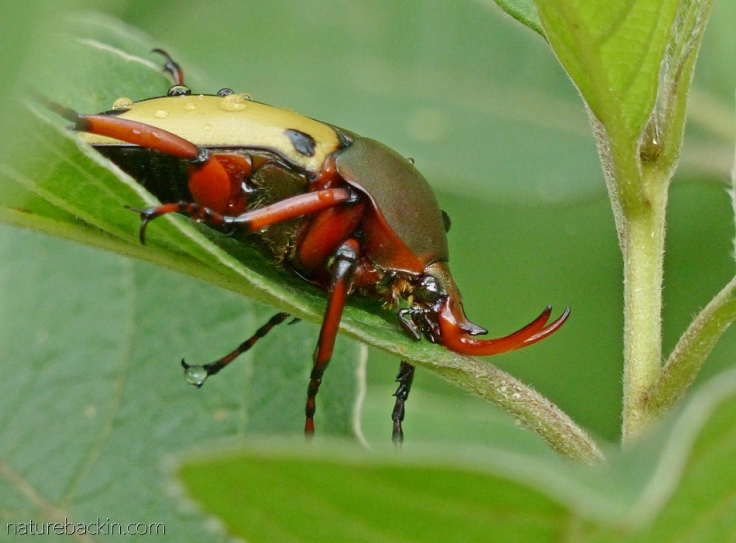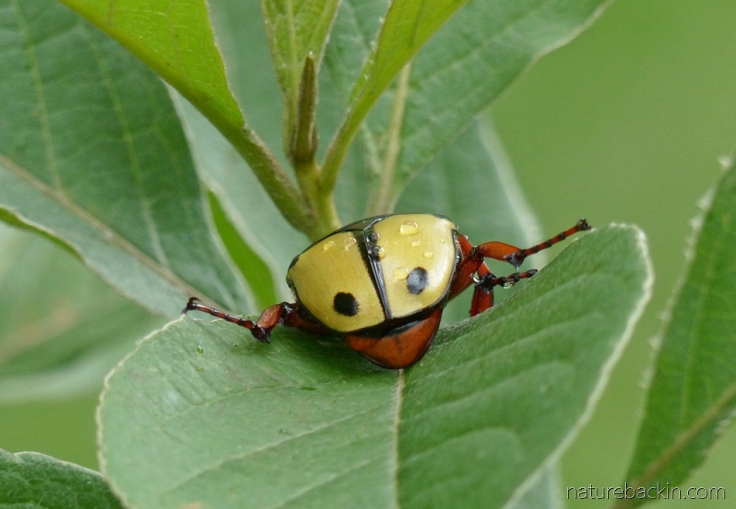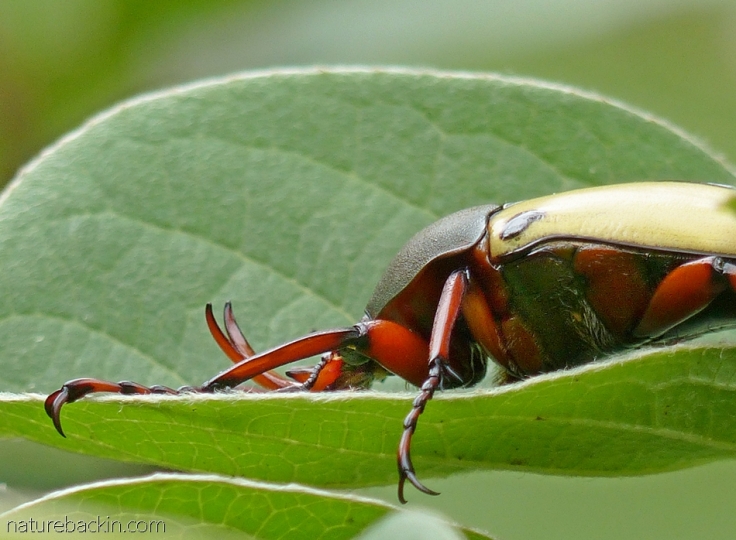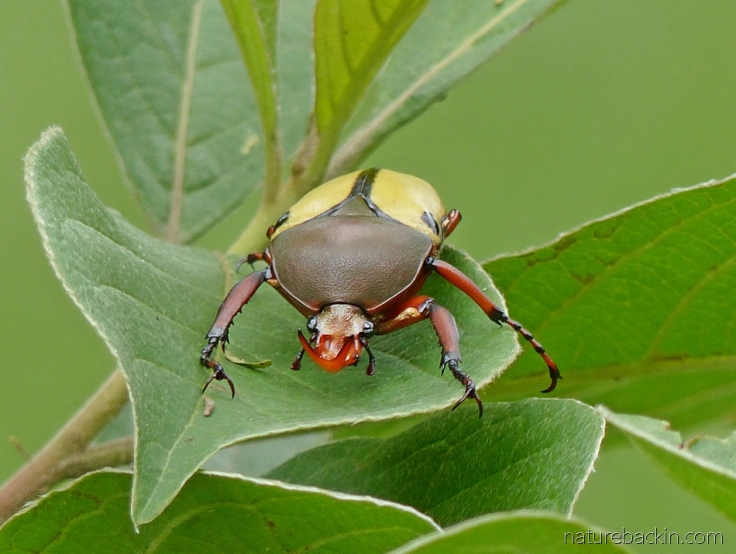I had not seen such a large, colourful beetle before, and definitely not one with such an ornate y-shaped horn projecting from its face. This beetle is so large and distinctive, at least it should be easy to identify I thought.
I was wrong! After lots of searching I have not been able to find an identical-looking beetle in all the places I have looked. I am pretty certain it is in the Scarabaedae family of beetles – known as scarabs – which is a huge family comprising 30 000 species worldwide and about 3000 species in southern Africa. So if the large beetle in our garden is a scarab, to find exactly which species it is out of so many might be a bit needle-in-the-haystackish.

When I first spotted the beetle on an overcast morning after light rain, it appeared to be fast asleep among the leaves of a Lebombo cluster-leaf sapling
I read that the family of scarab beetles includes dung beetles, chafers, rhinocerous beetles, and Goliath beetles among its members. After finding photos of some similarish beetles, I wonder if perhaps this beetle is a fruit or flower chafer, perhaps in the tribus Goliathini, maybe in the genus Mecynorhina? Any suggestions would be very welcome.

And here it is still sleeping, photographed from the other side
When I say this beetle is large, it is actually about 6 cm (2 inches) in length. Of course larger beetles do occur, but this is the largest beetle I have seen in our area. Such a horn usually occurs only in males, and it is used for fighting over mates or resources.

Here is a rear view of the beetle. I fancy that the two black dots, resembling eyes might perhaps be a deterrent to predators
One of the distinctive characteristics of scarab beetles is the antennae. At the tip of each antenna a club-like apex comprises 3-7 flat, moveable plates, which can be fanned out to scent odours.

In this photo of the beetle, the antennae with the ends furled into clubs can be seen on either side of the two-pronged horn
All beetles undergo four phases of metamorphoses – from egg to grub-like larvae, to pupa, to adult beetle. The larvae resemble pale slightly curled caterpillars and they mostly live underground or under plant debris and are not exposed to the sun. Adults and larvae of scarab beetles, depending on the species, eat fresh or decaying plant matter, nectar, dung and fungi. Fresh plant matter may include fruit, flowers and sap.

All six legs of this beetle end in a forked “foot” that appears to be adapted for hooking onto things rather than grasping. Although this beetle seemed to be rather clumsy, it did manage to hook onto a leaf when hanging upside down underneath

Here is the beetle partially concealed as it hangs upside down under a leaf, using its hooked ‘feet’ or ‘toes’ to hang onto the leaf

A close-up the beetle keeping a low profile and showing its jointed legs and hooked ‘toes’
I kept an eye on the beetle off and on throughout the morning. It moved from its sleeping spot to spend quite some time under a leaf and then as the temperature rose slightly as the cloud cover thinned it moved out onto the top of a leaf as if to warm up. With hindsight I think that perhaps it was warming up in preparation for flying.

The beetle apparently warming up in the glow of the sun that is penetrating through a thin layer of clouds and radiating a degree of warmth
Just after I took the above photo, the beetle started moving around and fell off the leaf. I bent down to see it hanging under another leaf that was lower down, but it fell off that leaf too, as can be seen in the video below. The second time it fell to the ground, it crawled to the stem of the small tree and started climbing back up and then, before I could get my camera on it, it suddenly launched itself off the stem and took flight, bumbling off rapidly to disappear through the trees and not to be seen again.
In this short video, not a lot happens, but it does show something of the beetle’s rather other-worldly quality. Oh and by the way, the tinnitus-like background noise is actually the sound of chorusing cicadas.
So, discovering this beetle has been rather tantalising, and it seems remarkable that I have not been able to identify such a large and distinctive beetle – but then the 3000 species of scarab beetles in southern Africa won’t all be covered in illustrated reference books, field guides and websites. And in a way, the lack of identification adds to its rather extra-terrestrial demeanour and allure.

References: Picker, Mike, Griffiths, Charles & Weaving, Alan. 2019. Field Guide to Insects of South Africa. Cape Town: Struik Nature; Wikipedia. 2019. Scarabaeidae. https://en.wikipedia.org/wiki/Scarabaeidae
Posted by Carol









April 1, 2020 at 1:09 pm
Thank you Ronn. I am content to know the genus for now 🙂
LikeLike
April 1, 2020 at 6:17 am
Great photos and good luck in your search to identify it
LikeLiked by 1 person
March 7, 2020 at 5:55 pm
I enjoyed this immensely! The mystery of this magnificent visitor to your garden has my attention. I will remember this critter when/if you ever definitively name it and come back to tell us about it. Beautiful beetle!
LikeLiked by 1 person
March 8, 2020 at 7:41 pm
Thanks very much Cheryl – who would have thought a beetle could be so magnificent? I am content to stick with the genus as identified and not be too bothered as to the exact species.
LikeLiked by 1 person
March 8, 2020 at 7:48 pm
Yes, what matters is that it came, you saw it, you appreciated it, you shared it.
LikeLiked by 1 person
March 8, 2020 at 7:54 pm
🙂
LikeLike
February 27, 2020 at 9:45 pm
Your close ups are always so amazing! The beetle is so colorful it almost reminds me of a child’s toy…just beautiful!
LikeLiked by 1 person
February 28, 2020 at 10:28 am
I love that analogy to a child’s toy. Magical.
LikeLike
February 22, 2020 at 2:09 pm
What a find! and an intriguing tale…
LikeLiked by 1 person
February 23, 2020 at 6:29 pm
Thank you Nikki – it was a lovely find, and the joint effort at ferreting out an ID was interesting too 🙂
LikeLike
February 22, 2020 at 8:04 am
Simply stunning Carol! It gives such a thrill to ‘find’ something ‘new’, doesn’t really matter if it has been described before, your account is fresh, new and vital, sharing your excitement! xxx
LikeLiked by 1 person
February 23, 2020 at 6:28 pm
Thanks Christeen. Yes it was special to see such a spectacular and intriguing beetle for the first time.
LikeLiked by 1 person
February 21, 2020 at 5:06 pm
Oh. My comment has disappeared. Ah well. But I’m so glad to look at the post again on arriving home. I read it on my phone while I was away, and this looks so much better in Full Size. What a spectacular creature. I’m sorry though that it seems to have missed its chance of being called after you though Carol!
LikeLiked by 2 people
February 23, 2020 at 6:24 pm
Those disappearing comments are perplexing. I have checked my spam folder and your comment didn’t go there btw.
Yes he is a spectacular beetle, and luckily for him he already has a name 🙂
LikeLiked by 1 person
February 24, 2020 at 10:13 am
Lucky him. And WP’s comments mechanism is a system that sometimes passeth all understanding.
LikeLiked by 1 person
February 21, 2020 at 2:54 pm
I am glad to see this mystery beetle has been identified. He is quite a handsome chap, isn’t he? Must say I felt a bit embarrassed on his behalf when he fell off those leaves twice in such an ungainly manner. (excuse the anthropomorphization)
LikeLiked by 1 person
February 22, 2020 at 6:52 pm
Well I agree that he is handsome 🙂 And perhaps he was embarrassed too, which is why he flew away 🙂
LikeLike
February 22, 2020 at 9:05 pm
😀
LikeLiked by 1 person
February 21, 2020 at 2:51 pm
I hope someone helps with the identification of this mystery beetle. He is quite a handsome chap, isn’t he? Must say I felt a bit embarrassed on his behalf when he fell off those leaves twice in such an ungainly manner. (excuse the anthropomorphization)
LikeLike
February 21, 2020 at 9:03 am
Oh wow! What a fabulous find you have there, Carol! Looks like you got your id in the end which is great. Nothing worse than not knowing what you have. Marvellous photos of this magnificent beetle!
LikeLiked by 1 person
February 21, 2020 at 12:57 pm
Thanks very much Pete. I was pretty astounded when I first saw it and quite taken with the fact that it seemed to be sleeping. Yes I am happy to at least have the genus (and probably the species too is confirmed), though it is magnificent whatever the ID 🙂
LikeLiked by 1 person
February 21, 2020 at 8:08 am
I think it has consumed some toxic substance, maybe dagga or Dave’s beer. Hopefully it will survive for another look.
LikeLiked by 1 person
February 21, 2020 at 11:47 am
Hopefully! 🙂
LikeLike
February 21, 2020 at 6:18 am
My money’s on it being this one (but please feel free to delete this comment, Carol, to keep the mystical quality of your post):
http://www.beetlesofafrica.com/beetle_detail.asp?beetleid=847&page=1&count=y
LikeLiked by 1 person
February 21, 2020 at 7:03 am
Thanks very much Dries – this species you identify is on my shortlist too (see my comment to Graham) – there is subspecies of E. smithii that occurs in KZN and that might also be a contender.
Isn’t it odd that we find it hard not penetrate the mystery after all 🙂
LikeLiked by 1 person
February 21, 2020 at 10:16 am
We like a challenge! 😀
LikeLiked by 1 person
February 21, 2020 at 1:01 pm
Indeed. Btw, as I commented to Ark, I discovered that E. smithii and E. euthalia natalensis are synonymous names!
Hopefully this link works http://www.catalogueoflife.org/col/details/species/id/4a69014ccd6d46a3978b4989a83a667b/synonym/325998b8b9c68fb6dbf176edba6e7a18
LikeLiked by 1 person
February 21, 2020 at 1:04 pm
As the mystery is unfolding it’s actually getting more and more interesting – I love that we’re all learning together and really grateful to you for lighting the spark with this post, Carol!
LikeLiked by 1 person
February 21, 2020 at 1:07 pm
It is really good to share in this collaboration 🙂
(I nearly didn’t do the post because I did not have the ID and now I am glad that I did.)
LikeLiked by 1 person
February 21, 2020 at 2:43 pm
We all are!
LikeLiked by 1 person
February 21, 2020 at 6:11 am
What a spectacular creature, Carol, and I agree that not knowing exactly what it is, where it comes from and where it is going seems rather fitting! Isn’t it wonderful to find that there’s still so much to discover!
LikeLiked by 1 person
February 21, 2020 at 6:59 am
He is indeed a spectacular creature. Ark has lifted the veil of mystery somewhat, identifying the genus as Eudicella.
It is wonderful (and sometimes daunting?) that there is still so much to discover (and more than I can ever learn!). I am a dyed-in-the-wool generalist, but I can quite see the need for specialists 🙂
LikeLike
February 21, 2020 at 4:51 am
Isn’t he gorgeous, in his ‘bumbling’ clumsy way as you so aptly describe him.. hope you can find a name for your mystery visitor!
LikeLiked by 1 person
February 21, 2020 at 6:56 am
Thanks Carol – I think he is gorgeous too. As you will see in the comments Ark has been able to identify the genus as being Eudicella, which is great to know.
LikeLike
February 21, 2020 at 3:29 am
its amazing being so “clumsy” it has survived. lol
LikeLiked by 1 person
February 21, 2020 at 6:55 am
🙂 It would be interesting to know if it usually feeds on plants that are easier to hang on to!
LikeLiked by 1 person
February 21, 2020 at 12:06 am
Great photos and what a colorful fellow. I’m with Arkenaten on the Eudicella ID. The closest I’ve found is Eudicella tetraspilota euthalia. Here are a couple of links to similar images: http://flower-beetles.com/foto/eudicella%20tetraspilota%207.jpg & https://www.biolib.cz/en/taxon/id1251023/. Seems like there are several similar Eudicella sub species so maybe Arkenaten’s entomologist will be able to pin it down.
I’ve had similar experiences of seeing something really distinctive, be it insects or plants or fish, and figuring it will be easy to ID and some of them are still in my ‘mystery’ folder.
LikeLiked by 1 person
February 21, 2020 at 6:54 am
Thank you Graham – it is great to know the genus and it is so nice of Ark to have found that out. I agree that it looks a lot like the E. tetraspilota euthalia but I have not found it confirmed it occurs in SA. Here are some other contenders! Eudicella smithii, E. trimeni, and E. euthalia natalensis. There are likely to be others too! Thanks so much for looking it up.
Your mystery folder sounds to be intriguing, if a little frustrating!
LikeLiked by 1 person
February 22, 2020 at 5:35 am
Glad to see you have it narrowed down pretty well. I thought your photos compared favorably to those I was looking at while trying to ID the beetle.
LikeLiked by 1 person
February 23, 2020 at 6:26 pm
Thanks Graham. Yes, I am happy enough just to know the genus actually. Some insects can be so variable even within a species.
LikeLiked by 1 person
February 24, 2020 at 6:36 am
Yes, some things simply can’t be pinned down without cutting them up and analyzing the remains. Best to leave them alive to get on with it.
LikeLiked by 1 person
February 20, 2020 at 10:01 pm
What a fun discovery, Carol, he’s definitely a colorful fellow. It proves that, at least in the insect world, there is still much yet to be discovered.
LikeLiked by 1 person
February 21, 2020 at 6:45 am
That is so true – I understand that even entomologists still have much to discover.
LikeLiked by 1 person
February 20, 2020 at 8:35 pm
That is one imposing beetle, Carol. I hope you are able to ferret out its identity.
LikeLiked by 1 person
February 21, 2020 at 6:16 am
Thank you Sandy. As you will see from the comments, Ark has ferreted out the ID.
LikeLiked by 1 person
February 21, 2020 at 4:31 pm
Great.
LikeLiked by 1 person
February 20, 2020 at 8:26 pm
Maybe it’s a previously unknown species?
LikeLiked by 2 people
February 20, 2020 at 8:30 pm
Perhaps we can invent a name for it! 🙂
LikeLiked by 1 person
February 20, 2020 at 8:47 pm
I am busy chatting on Facebook with an entomologist by the name of Dr. Art Evans. he reckons it is a flower chafer in the genus Eudicella.
I’ve asked him if this one has a specific name.
I’ll let you know.
LikeLiked by 1 person
February 21, 2020 at 6:45 am
Thank you so very much Ark – that is really helpful. I have been looking at species of Eudicella to see if any that look like the one I saw occur in South Africa. There are a few contenders (as I have commented to Graham).
Thanks also to Dr Evans for his help.
LikeLiked by 1 person
February 21, 2020 at 8:37 am
Here you go , Carol. I think we have a winner:
Eudicella smithii. Common name. Jade Headed Buffalo Beetle
And I think yours maybe be female.
Can’t find an exact colour match, but they all have the four spots on the carapace.
Maybe this is a unique/new variety?
LikeLiked by 1 person
February 21, 2020 at 9:10 am
Just been updated. It is male.
LikeLiked by 1 person
February 21, 2020 at 12:54 pm
Oh good – because that fits with what I have been reading 🙂 Thanks for confirming this.
LikeLiked by 1 person
February 21, 2020 at 12:53 pm
Thank you Ark. I had narrowed it down to E. smithii or E. euthalia natalensis as being the most likely and I have just read that in fact they are synonyms for the same species (see http://www.catalogueoflife.org/col/details/species/id/4a69014ccd6d46a3978b4989a83a667b/synonym/325998b8b9c68fb6dbf176edba6e7a18).
Perhaps the one that is browner rather than green (jade) headed is a regional difference (or even subspecies) in KZN. I have seen photos of an E. smithii similar to the one I saw that was photographed on the KZN north coast (and on one site referred to as North Coast Large Yellow Fruit Chafer). Thanks again very much for your assistance. It has been interesting learning about these remarkable beasties.
LikeLiked by 1 person
February 21, 2020 at 1:36 pm
It’s been great. We all learn.
LikeLiked by 1 person
February 20, 2020 at 8:22 pm
Beautifully photographed as always. I checked in my African Insect Life but found no ID for your spectacular looking beetle. It is always fun finding such creatures in one’s garden!
LikeLiked by 2 people
February 20, 2020 at 8:29 pm
Thanks for checking Anne. I was delighted to come across such a surprising creature.
LikeLiked by 1 person